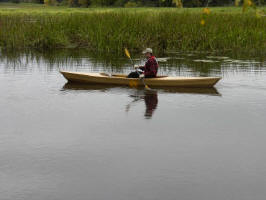
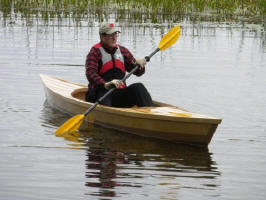
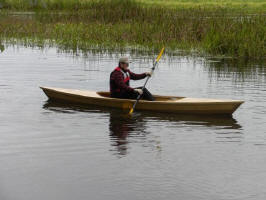
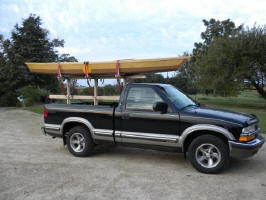
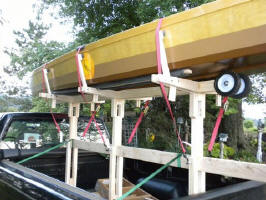
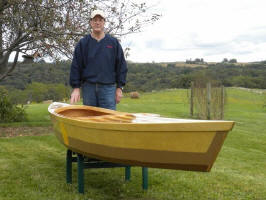
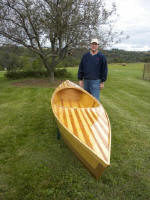
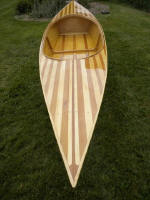
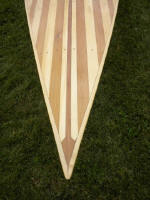
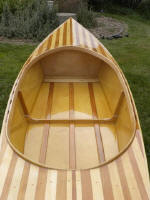
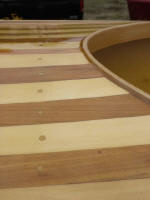
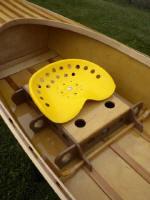
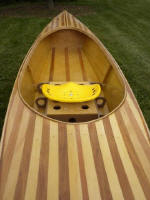
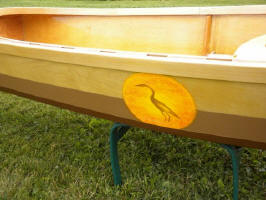
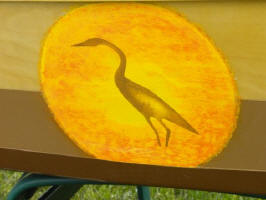
|
The observation and learning period and the actual construction time is hard to calculate. You are correct in your assumption that more than six hours was required. Assembling the ribs and component parts to the point where it looked like a boat took about twelve hours. From that point I worked on the "finishing" process whenever I could grab twenty minutes here and a half hour there for about eighteen months. The most important attribute that I relied on to incorporate my own design elements into the project was that I did "sweat the details" to ensure this boat was rendered with a high degree of precision and exacting standards of craftsmanship. Your basic design, which I already indicated, is both functional and beautiful in it's straightforward simplicity. My objective was to build a boat that did not diminish the tradition of good pirogue boat building. My efforts resulted in a pirogue that is 15'6" in length. The boat is 31" at the widest point of the beam. I deviated from your plans where the side panels of the boat are concerned. At midship line I increased the freeboard height to 12" tapering the cut to the recommended height to meet at the bow and stern plates. I constructed the boat with the thought that less could quite possibly be more when incorporating building materials into the boat. I used 3/16" double sided birch veneer plywood for the bottom and side panels of the boat. I used your recommended scarf joints to attach the eight foot sections of the side panels of the boat. All seams were fiberglassed. The entire boat, inside and out is fiberglassed with three coats of epoxy. Each coat was sanded and hand rubbed. I used the recommended materials provided by Larry at RAKA. The bulkheads are fiberglassed in and are water tight for flotation. The rub rails are special ordered sixteen foot lengths of hard rock clear maple that I ripped to 5/16 width that was rabbet (sp) cut to conceal the raw plywood edges at the inwale. The spacers at the inwale are cherry wood harvested from a windfall on my farm. The inwale is hard rock clear maple. To accomplish the "bend" it was necessary to design and build a steam chamber to allow the maple wood to be put in place. This was an interesting phase that requires more space than I have here to describe. In order to keep the boat's weight down the struts that support the decking were designed to resemble struts found in aircraft with holes drilled in each to shed mass. The decking is from strips of cedar and bass wood that were beveled as in barrel-stave construction for a clean fit. Each deck board is pegged as indicated in the photos. I added an eight foot by 3/4 " keel that allows the boat to track very well when under way. The cedar strips that you see in the bottom of the boat provide a bit of reinforcement as does the keel. These strips also serve as tracks that the seat platform "rides" on. This seat platform is notched to prevent lateral movement and locks in to eliminate forward and backward movement as well. I know that you recommended against 3/16 " plywood in the building of this boat. The way I have designed and built this boat it proves to be extremely strong and I have great confidence in its capabilities as a river and back-river boat. I finished the pirogue out with three coats of marine varnish. The bottom and water-line paint is a high quality exterior latex house paint. The primer is KilZ exterior grade. The graphic of the setting sun and heron is something I hand painted just for the heck of it. Once again, this was a project that I think was worth the planning, design and detailed rendering of my thoughts on a fine Cajun pirogue. I look forward to many years of enjoyment fly fishing for trout on some of the rivers in our area as well as paddling and fishing on the Mississippi and it tributaries. Kindest regards |
(click images to enlarge)